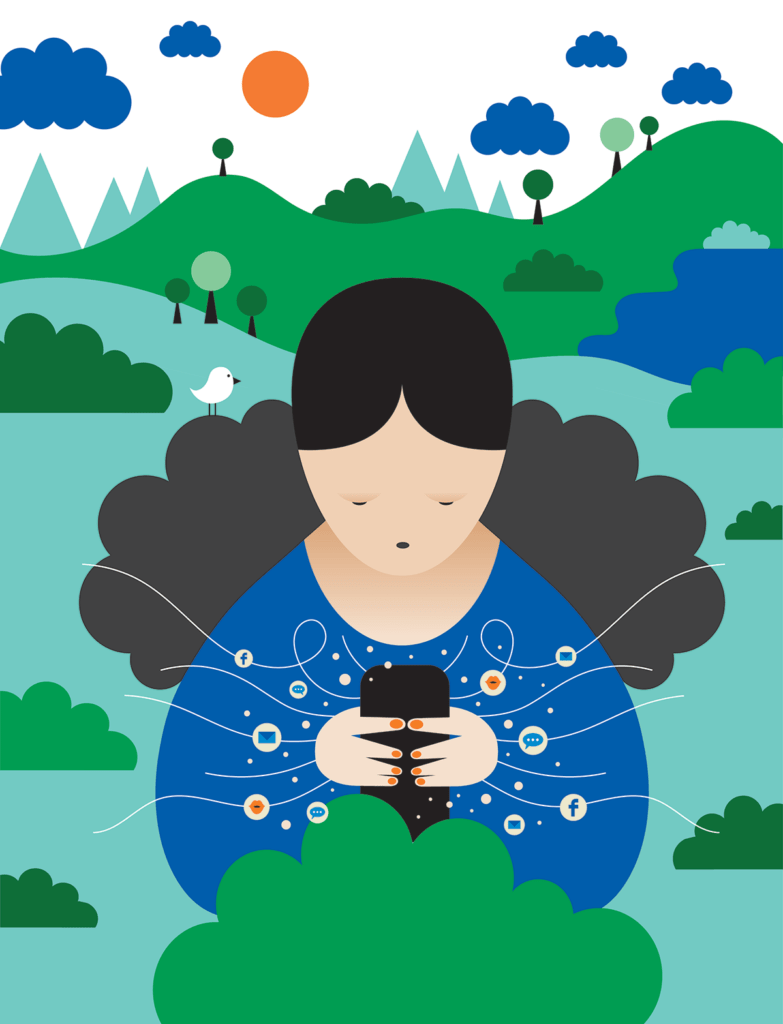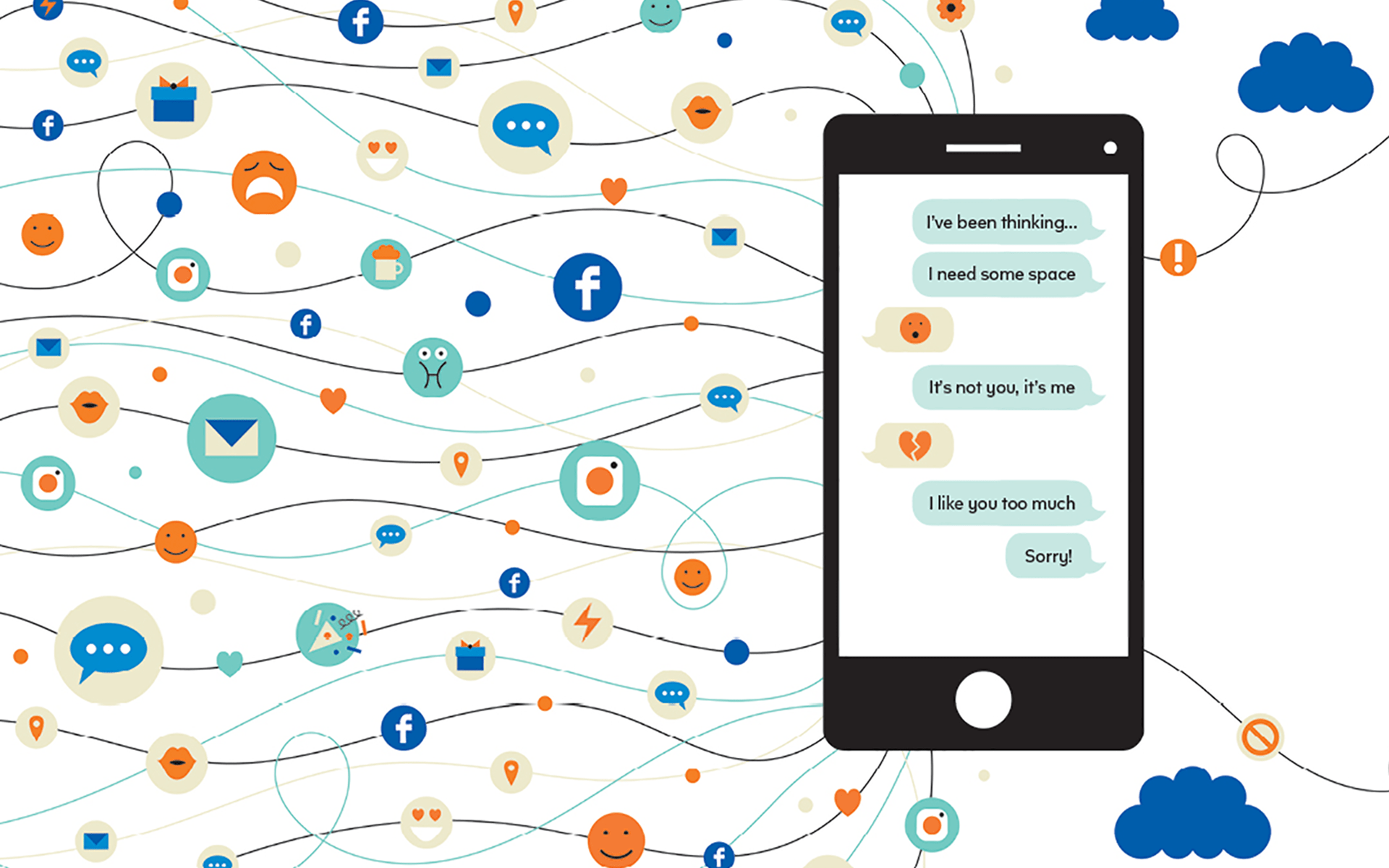Codependent. If any word captures the relationship between phone and user, it’s that one. And not just because we depend on our phones and our phones depend on us. Too often our “codependence” is an unhealthy and unbalanced relationship with a sleek, seductive sliver of technology. The tell-tale signs: cramps in our “texting thumbs”; sleep lost to round-the-clock games; conversations with friends and partners that go nowhere because our eyes—and attention—are plugged in elsewhere.
With tech addiction, as with all kinds of dysfunctional relationships, identifying the problem doesn’t automatically make it better. The American Psychological Association’s 2017 Stress in America report, which surveyed over 3,500 American adults, revealed that 65% believe they should periodically unplug or do a digital detox to improve their mental health. However, only 18% report actually doing so.
Phone addiction is real.
The reason lies partly in our neurochemistry. As smartphones keep us informed, connected, and distracted, our brains get used to a steady flow of stimulation. Over time, merely picking up the phone triggers the release of dopamine, that tiny blip of excitement and satisfaction. Like any high, the feel-good sensation doesn’t last and our brains hunger for the next hit. Ping! and we’re reaching for another fix: an addiction cycle that plays out, on average, 47 times per day.
The brain’s modern craving for constant connection—with one-time acquaintances, total strangers, and your cousin’s cat’s Instagram—can leave us disconnected from the people and the things that really matter. A 2018 study found participants who were highly preoccupied with their phones showed greater absent-mindedness and difficulty focusing on tasks. They also experienced less well-being and life satisfaction. Sadly, we’ve become so convinced that we need our phones all the time—to assuage our FOMO—that we’re lulled into missing out on real life. Our own well-being and relationships take a backseat.
These are the problems journalist Catherine Price set out to solve. Troubled by her own phone habits, Price researched what undergirds our tech relationships and tested ways to transform them. As described in her most recent book, How to Break Up with Your Phone, Price devised a Technology Triage that is a gentle yet motivating warm-up for creating healthier phone boundaries. You’ll jump-start the practice of mindfully noticing how you relate to your phone, and learn to shift from self-sabotaging phone habits to new patterns that leave time and mental freedom for the people, experiences, and dreams you really care about.

Monday: Download a Tracking App
The first step is to compare the amount of time we think we’re spending on our phones to how much time we’re actually spending on them. Start by jotting down your answers to these questions:
- If you had to guess, how many times a day do you think you pick up your phone?
- How much time do you estimate that you spend on it per day?
Next, download a time-tracking app that will automatically monitor how often you reach for your phone and how long you spend on it. (Use a third-party app or a built-in tracking feature, such as Screen Time for iOS, to determine how much time you are spending on your phone each day, and on which apps.) Don’t try to change anything yet about your behavior; our goal is just to gather data. We’ll touch base about your results in a few days.
Tuesday: Assess Your Current Relationship
Now that you’ve got a tracking app up and running in the background, pull out a notebook or create a new email message to yourself (or just get a pen and write in the margins) and write a few sentences in response to the following questions:
- What do you love about your phone?
- What don’t you love about your phone?
- What changes do you notice in yourself—positive or negative—when you spend a lot of time on your phone? (Depending on how old you are, you can also ask yourself if you’ve noticed any changes since you got a smartphone.) For example, you may have noticed that you automatically start reading news and checking apps, instead of observing what’s going on around you. Maybe your attention span is shorter and you don’t bother to memorize details, since you can always look them up. Maybe you have pain in your neck or thumbs from texting.
Next, imagine yourself at the end of your breakup. What would you like your new relationship with your phone to look like? What would you like to have done or accomplished with your extra time? What would you like someone to say if you asked them to describe how you’d changed? Write your future self a brief note or email describing what success would look like, and/or congratulating yourself for achieving it.
Wednesday: Start Paying Attention
The next step is to pay attention to how and when you use your phone, and how you feel when you do so.
Over the next 24 hours, try to notice:
- Situations in which you nearly always find yourself using your phone. (For example, waiting in line, in the elevator, in the car.)
- How your posture changes when using your phone. (Is your back hunching? Do your shoulders tighten up?)
- Your emotional state right before you reach for your phone.
- Your emotional state right after you use your phone. (Do you feel better? Worse? Did your phone satisfy whatever emotional need caused you to reach for it?)
- How and how often your phone grabs your attention (via notifications, texts, and the like).
- How you feel while you are using your phone—as well as how you feel when you realize that you don’t have your phone.
- Moments—either on or off your phone—when you feel some combination of engaged, energized, joyful, effective, and purposeful. When that happens, notice what you were doing, whom you were with, and whether your phone was involved.
- How and when other people use their phones—and how it makes you feel.
Lastly, I’d like you to choose several moments in your day when you seem to pick up your phone the most often, and see if you can identify a consistent trigger that makes you repeat this habit. For example, maybe you check your phone first thing in the morning because you’re anxious. Or maybe it’s just because it’s on your bedside table. Maybe you check your phone in the elevator because everyone else is also checking their phone. Maybe you check it at work because you’re bored with whatever you’re supposed to be doing.
We’re not trying to put a judgment on any of these triggers; we’re just trying to become aware of them so that we can begin to identify patterns. Personally, I’ve noticed that while it can initially be pleasant, I hardly ever feel better after I use my phone—an observation that has helped me catch myself when I’m about to pick it up out of habit.
Thursday: Take Stock and Take Action
By now, we’ve tracked our phone usage for a few days. Now that we’ve gathered this data, let’s analyze it.
1. Look at the results from the tracking app you installed
The tracking data may not be entirely accurate, but that’s okay—we’re just trying to get a general sense of how our guesses match up to reality.
How many times per day did you pick up your phone, and how much time did you spend on it? How does this compare to your guesses? What, if anything, surprised you?
2. Notice what you’ve noticed
Next, review the list of questions from yesterday and consider what you’ve noticed over the past 24 hours about when and why you typically use your phone. What patterns did you notice? What, if anything, surprised you?
3. Create your first speed bump
One of the most effective ways to regain control over our phones is to build speed bumps: small obstacles that force us to slow down. By creating a pause between our impulses and our actions, speed bumps give us the chance to change course if we decide we want to take a different route.
This first speed bump is an exercise that I call WWW, which is short for What For, Why Now, and What Else (you might want to consider putting “WWW” on your lock screen as a reminder).
WWW: What For, Why Now, and What Else
Any time you notice that you are about to reach for your phone, take a second to ask yourself:
What For? What are you picking up your phone to do? (For example, to check your email, browse Amazon, order dinner, kill time, and so on.)
Why Now? Why are you picking up your phone at this moment? The reason might be practical (I want to take a photo), situational (I’m in the elevator), or emotional (I want a distraction).
What Else? What else could you do right now besides check your phone?
If you do your Ws, and then decide that you really do want to use your phone right now, that’s totally fine. The point is simply to give yourself a chance to explore your options for that particular moment, so that if and when you turn your attention to your phone, it’s the result of a conscious decision.
Identifying your goal ahead of time also prevents an impulse to share a photo on social media from devolving into another 30 minutes spent absent-mindedly scrolling through your feed.
Friday: Delete Social Media Apps
Social media is like junk food: Bingeing on it makes us feel bad, and yet once we start consuming it, it’s really hard to stop. So let’s take control of it by deleting all social media apps from your phone.
I’m serious. Do it now. Put your finger on an app icon until it starts jiggling, and then press the x in the corner. The app, panicking, will respond with a manipulative question (“Are you really sure you want to delete me and all my data?”). Say yes and then shake your head in disgust: Everyone knows that Facebook didn’t really delete any of your data. It’s all still lurking in the cloud, ready to be used against you and reinstalled/downloaded at any time.
I’m not trying to get you off of social media entirely; I just want you to check it through your phone or computer’s internet browser instead of on an app. This creates a speed bump, because browser versions of social media platforms often have fewer features than their apps and are clunkier to use. So they provide lots of opportunities to ask yourself whether you really want to be checking social media at that moment.
If you decide that you do, define your purpose ahead of time (Are you posting something? Looking for something specific? Just scrolling for fun?) and decide how long you want to spend. You may even want to set a timer. When you’re done, log out and close the window so that it won’t open automatically the next time you launch the browser.
Lastly, make a point of taking some of the time you usually spend on social media and spending it with people you care about instead—offline. Call a friend. Invite someone to coffee. Have a party. (Yes, you can use social media to help you organize.) Notice how you feel afterward, especially compared to how you usually feel after spending time on social media.
Saturday: Come Back to (Real) Life
If you use your phone less, you’re going to end up with more time. Unless you have some sense of how you want to be spending this reclaimed time, you’re likely to feel anxious and possibly a bit depressed—and you’ll be at risk of sliding right back into your old habits. That’s why we need to get back in touch with what makes us happy in our offline lives. We’re going to start with a few prompts. Just jot down whatever comes to mind.
- I’ve always loved to:
- I’ve always wanted to:
- When I was a kid I was fascinated by:
- If I had more time, I would like to:
- Some activities that I know put me into flow are:
- People I would like to spend more time
- with include:
Once you’re done, use your answers to those questions to make a list of fun, off-phone things you could do over the next few days. For example: Do a crossword in a café. Go on a day trip. Sign up for a class. Plan a game night. Go to a museum. Our goal here is to come up with ideas—and plans—for fun things ahead of time, so that when you find yourself with free time, you’ll be less likely to reach for your phone.
Sunday: Get Physical
Most of us weren’t very good at mind–body integration even before smartphones came into the picture—and with every screen we add to our lives, we’re only getting worse. So today, make some time to get back in touch with your body by doing something physical and enjoyable—a chance to remember you are more than a brain sitting on top of a body. And, as a side note, there’s strong evidence suggesting that increased blood flow also helps to strengthen your cognitive control.
Some ideas:
- Go for a walk (without your phone).
- Pay attention to your breath and the feeling of your body as it moves.
- Play catch.
- Get a massage (get in touch with your body by having someone else get in touch with your body).
- Play one of those video games that require you to jump around a lot.
- If you usually listen to music while you exercise, try turning it off for a bit and tuning in to your body and breath.
To practice, put down this magazine, take a deep breath, and slowly stretch your arms above your head. Bring them back down as you exhale. Notice how it feels.

How to Ride Out Your Phone Cravings
Studies of people trying to quit other addictive habits, such as smoking, have suggested that if we simply acknowledge our discomfort without trying to fight against it—in other words, if we ride out the wave—our cravings will eventually fade on their own.
For example, let’s say you catch yourself reaching for your phone. Practicing mindfulness means that instead of trying to fight your urge or criticizing yourself for having it, you simply notice the urge and stay present with it as it unfolds. As it does, you can ask questions about it. What does the craving feel like in your brain and in your body? Why are you having this particular urge right now? What reward are you hoping to receive, or what discomfort are you trying to avoid? What would happen if you reacted to the impulse? What would happen if you did nothing at all?
The next time you find yourself tempted to look at your phone, pause instead. Take a breath and just notice the craving. Don’t give in to it, but don’t try to make it go away. Observe it. See what happens.
Shift Your Mindset
Here’s an interesting psychological trick for you: Researchers have found that the vocabulary you use to describe a new habit has a strong effect on the likelihood that you’ll stick with it. To be specific, saying that you “do” or “don’t” do something—framing an action as part of your identity—is much more effective than saying that you “have to” or “can’t” do something.
So when you feel the urge to open or reinstall one of the apps, don’t try to resist it by saying that you “can’t” or aren’t “allowed” to do so. Instead, simply describe your current reality: “I do not keep social media apps on my phone.” This simple shift can make a surprising difference.





